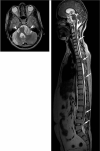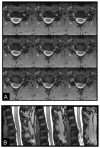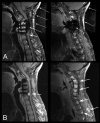Cutting-edge imaging of the spine
- PMID: 17493543
- PMCID: PMC2080848
- DOI: 10.1016/j.nic.2007.01.003
Cutting-edge imaging of the spine
Abstract
Damage to the spinal cord may be caused by a wide range of pathologies and generally results in profound functional disability. A reliable diagnostic workup of the spine is very important because even relatively small lesions in this part of the central nervous system can have a profound clinical impact. MR imaging has become the method of choice for the detection and diagnosis of many spine disorders. Various innovative MR imaging methods have been developed to improve neuroimaging, including better pulse sequences and new MR contrast parameters. These new "cutting-edge" technologies have the potential to impact profoundly the ease and confidence of spinal disease interpretation and offer a more efficient diagnostic workup of patients suffering from spinal disease.
Figures














Similar articles
-
Magnetic resonance imaging of the spine at 3 Tesla.Semin Musculoskelet Radiol. 2008 Sep;12(3):238-52. doi: 10.1055/s-0028-1083107. Epub 2008 Oct 10. Semin Musculoskelet Radiol. 2008. PMID: 18850504 Review.
-
MR imaging of the spine: recent advances in pulse sequences and special techniques.AJR Am J Roentgenol. 1994 Apr;162(4):923-34. doi: 10.2214/ajr.162.4.8141019. AJR Am J Roentgenol. 1994. PMID: 8141019 Review.
-
BLADE Sequences in Transverse T2-weighted MR Imaging of the Cervical Spine. Cut-off for Artefacts?Rofo. 2015 May;36(2):102-8. doi: 10.1055/s-0034-1385179. Epub 2014 Sep 22. Rofo. 2015. PMID: 25912327 Review.
-
Pulse sequences in lumbar spine imaging.Magn Reson Imaging Clin N Am. 1999 Aug;7(3):425-37, vii. Magn Reson Imaging Clin N Am. 1999. PMID: 10494527 Review.
-
The use of MR contrast agents in the evaluation of disease of the spine.Top Magn Reson Imaging. 1995 Summer;7(3):168-80. Top Magn Reson Imaging. 1995. PMID: 7654395 Review.
Cited by
-
Primary non-Hodgkin lymphoma of the right femur and subsequent metastasis to the left femur: A case report and literature review.Oncol Lett. 2018 Apr;15(4):4427-4431. doi: 10.3892/ol.2018.7895. Epub 2018 Jan 29. Oncol Lett. 2018. PMID: 29541210 Free PMC article.
-
Cervical spinal cord multiple sclerosis: evaluation with 2D multi-echo recombined gradient echo MR imaging.J Spinal Cord Med. 2011;34(1):93-8. doi: 10.1179/107902610X12911165975025. J Spinal Cord Med. 2011. PMID: 21528632 Free PMC article. Clinical Trial.
-
Volumetric analysis of syringomyelia following hindbrain decompression for Chiari malformation Type I: syringomyelia resolution follows exponential kinetics.Neurosurg Focus. 2011 Sep;31(3):E4. doi: 10.3171/2011.6.FOCUS11106. Neurosurg Focus. 2011. PMID: 21882909 Free PMC article.
-
Comparison of wideband steady-state free precession and T₂-weighted fast spin echo in spine disorder assessment at 1.5 and 3 T.Magn Reson Med. 2012 Nov;68(5):1527-35. doi: 10.1002/mrm.24163. Epub 2012 Jan 27. Magn Reson Med. 2012. PMID: 22287191 Free PMC article.
-
Sensory neuronopathy involves the spinal cord and brachial plexus: a quantitative study employing multiple-echo data image combination (MEDIC) and turbo inversion recovery magnitude (TIRM).Neuroradiology. 2013 Jan;55(1):41-8. doi: 10.1007/s00234-012-1085-x. Epub 2012 Aug 26. Neuroradiology. 2013. PMID: 22922867
References
-
- Ghanem N, Uhl M, Brink I, Schafer O, Kelly T, Moser E, Langer M. Diagnostic value of MRI in comparison to scintigraphy, PET, MS-CT and PET/CT for the detection of metastases to bone. European Journal of Radiology. 2005;55:41–55. - PubMed
-
- Roemer PB, Edelstein WA, Hayes CE, Souza SP, Mueller OM. The NMR phased array. Magn Reson Med. 1990 Nov;16(2):192–225. - PubMed
-
- Pruessmann KP, Weiger M, Scheidegger MB, Boesiger P. SENSE: sensitivity encoding for fast MRI. Magn Reson Med. 1999 Nov;42(5):952–62. - PubMed
-
- Griswold MA, Jakob PM, Heidemann RM, Nittka M, Jellus V, Wang J, Kiefer B, Haase A. Generalized autocalibrating partially parallel acquisitions (GRAPPA) Magn Reson Med. 2002 Jun;47(6):1202–10. - PubMed
-
- Hollingworth W, Todd CJ, Bell MI, Arafat Q, Girling S, Karia KR, Dixon AK. The Diagnosis and Therapeutic Impact of MRI: an Observational Multi-centre Study. Clinical Radiology. 2000;55:825–831. - PubMed
Publication types
MeSH terms
Grants and funding
LinkOut - more resources
Full Text Sources
Medical

